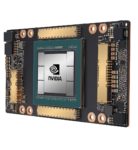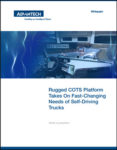The company that built the world’s nos. 2 and 3 most powerful supercomputers is to all appearances backing away from the supercomputer systems business. IBM, whose Summit and Sierra CORAL-1 systems set the global standard for pre-exascale supercomputing, failed to win any of the three exascale contracts, and since then IBM has seemingly withdrawn from the HPC systems field. This has been widely discussed within the HPC community for at least the last 18 months. In fact, an industry analyst told us that as long ago as the annual ISC Conference in Frankfurt four years ago, he was shocked when IBM told him the company was no longer interested in the HPC business per se….
Video: NVIDIA Launches Ampere Data Center GPU
In this video, NVIDIA CEO Jensen Huang announces the first GPU based on the NVIDIA Ampere architecture, the NVIDIA A100. Their fastest GPU ever is in now in full production and shipping to customers worldwide. “NVIDIA A100 GPU is a 20X AI performance leap and an end-to-end machine learning accelerator – from data analytics to training to inference. For the first time, scale-up and scale-out workloads can be accelerated on one platform. NVIDIA A100 will simultaneously boost throughput and drive down the cost of data centers.”
Video: Machine Learning for Weather Forecasts
Peter Dueben from ECMWF gave this talk at the Stanford HPC Conference. “I will present recent studies that use deep learning to learn the equations of motion of the atmosphere, to emulate model components of weather forecast models and to enhance usability of weather forecasts. I will than talk about the main challenges for the application of deep learning in cutting-edge weather forecasts and suggest approaches to improve usability in the future.”
Video: Fighting COVID-19 with HPE’s Sentinel supercomputer through the cloud
At HPE, we believe in being a force for good, so when the COVID-19 pandemic struck, HPE quickly made available supercomputing resources, along with a dedicated technical staff, free of charge to help scientists tackle complex research. That’s when we met Dr. Baudry and set him and his team up on HPE’s Sentinel supercomputer, which can perform 147 trillion floating point operations per second and store 830 terabytes of data. Sentinel – which is as fast as the earth’s entire population performing 20,000 calculations per second – is significantly accelerating discovery and saving months of research time and hundreds of thousands of dollars.
Transforming Private 5G Networks
The high bandwidth and low latency of 5G is truly transformational for the enterprise. Private 5G networks will enable business to offer new services through connected devices on the Edge and entirely new revenue streams. “Advantech Networks & Communications Group is driving innovation in next-generation network solutions with their High Performance Servers. The systems are cost effective, highly available and optimized to meet next generation networking and media processing needs.”
SDSC Expanse Supercomputer from Dell Technologies to serve 50,000 Users
In this special guest feature, Janet Morss at Dell Technologies writes that the company will soon deploy a new flagship supercomputer at SDSC. “Expanse will deliver the power of 728 dual-socket Dell EMC PowerEdge C6525 servers with 2nd Gen AMD EPYC processors connected with Mellanox HDR InfiniBand. The system will have 93,000 compute cores and is projected to have a peak speed of 5 petaflops. That will almost double the performance of SDSC’s current Comet supercomputer, also from Dell Technologies.”
Video: Overview of the Fujitsu A64fx processor
This video from Coreteks provides an overview of the Fujitsu A64FX processor that will power the pending Fugaku supercomputer in Japan. “The A64FX is a many core CPU like AMD Epyc or Intel’s Xeons, but at the same time it behaves like a GPU in some workloads matching NVIDIA’s most powerful offering, Volta. Today we’ll look at how this chip operates, why it could challenge Intel, AMD, NVIDIA and cloud and hyperscalers and what it could mean for us PC enthusiasts.”












